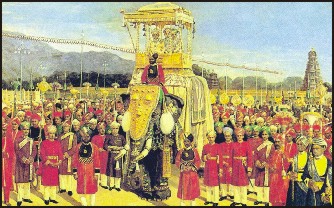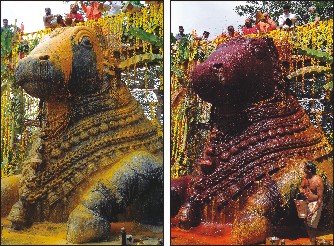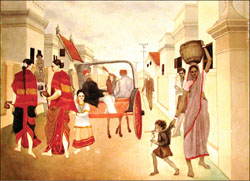
by Prof. A.V. Narasimha Murthy, former Head, Department of Ancient History and Archaeology, University of Mysore
Navaratri or Dasara is one of the most popular festivals in our country but it is celebrated in a variety of ways in different parts. Actually it is a festival symbolising the destruction of evil and establishment of good (dushta sikshana and shista rakshana). This festival has a hoary antiquity going back to the time of the puranas and epics. The word Dasara is derived from the Sanskrit Dashahara meaning ten days. Basically, Navaratri is a festival of Mother Goddess who received power from no less than Vishnu, Shiva and Agni. Each one of the Gods gave different powers to Her so that She could free the world from the tormentors of different types. Thus was born the indomitable energy personified in the form of Goddess and people heaved a sigh of relief. Navaratri means paying respects and showing gratitude to Mother Goddess.
As the demons had obtained various boons from Shiva or Vishnu, the Goddess had to assume different forms to achieve her goal. She is worshipped in the following nine forms namely, Mahakali, the destroyer of Madhu Kaitabha; Mahishamardhini, the destroyer of Mahishasura; Chamundi, the vanquisher of chanda-munda; Kali, the killer of Raktabija; Durga, the harbinger of destruction of Kamsa; Raktadantri, the great destroyer; Shakambari, the destroyer of famines; Durga, the destroyer of demon Durga; Bhramari, the killer of demon Aruna. Thus Devi assumed these forms to accomplish her task. In course of time, the worship of Saraswati and Lakshmi were also added.
Another significant aspect of this ritual is the exalted position of unmarried girls (kannikas) who are supposed to personify the great Goddess. These unmarried girls are worshipped as Kumari, Trimurti Kalyani, Rohini, Chandike, Sambhavi, Durga, Subhadra and Kali. Each one of them is worshipped during the nine days; they are fed and given gifts too.
It has been our unique tradition that these festivals are recommended to human beings only after they are tested by the Gods. The Gods themselves did this after vanquishing the demons. It is said that Sri Rama invoked the Goddess and achieved great victory over Ravana on the day of Vijayadashami. Thus even Sri Rama worshipped her before taking up a major fight. Even the great epic Mahabharata extols the greatness of this festival.
The Pandavas, who had hidden their weapons under the Shami tree (banni mara) worshipped the Goddess, took out the weapons and started their Digvijaya or Victory March and consequently achieved great success over the Kauravas. It has to be noted that in all these instances, the great Goddess is invoked and worshipped not for any personal gains but for the annihilation of the wicked people, upholding of dharma and to save the good people.
Thus when it was useful to the Gods, the human beings felt that it should be useful to themselves also and hence began celebrating Navaratri. No dobut, it was celebrated in the ancient period but it has not been recorded either in literature or in inscriptions till we come to the medieval period. It was believed that Samudragupta, Harsha, Vikramaditya VI, Ballala II, Singhana and a host of others started their Digvijaya on the Vijayadashami Day.
However, with the dawn of Vijayanagar period, historical records are available in plenty. Particularly, the writings of the foreign travelers who stayed for a short period in Vijayanagar empire have given graphic description of the various rituals and durbar during this period. The earliest reference to Dasara festival during the Vijayanagar period is seen at the time of King Devaraya II (1424-1446). Abdul Razzak, a Persian traveler, who was invited as a guest for Dasara, was greatly impressed by the festival and has given a long description. The infidels of this country who are endowed with great power are fond of displaying their pomp and glory. Navaratri was celebrated at Mahanavami platform (dibba) in Hampi. All the subordinate kings assembled here and made gifts to the emperor. Elephants played an important role besides horses. There were many pavilions and some of them revolved around. The King sat on the gold throne kept on the ninth storey. Acrobatics displayed were of high order and people enjoyed it. The King gave prizes to the participants who included men and women. The last three days, namely Durgashtami, Mahanavami and Vijayadashami were spectacular. Krishnadevaraya’s Dasara was held from morning till night and thousands of lamps were lit during the night. Wrestling was a great attraction. Fire works were of high order.
On the Vijayadashami Day, the King held a review of the forces. Another traveler by name Nuinz has also given a similar description, besides Barbara, Nikitin and others. From all these features, it becomes clear that Vijayanagar Kings laid the firm foundation for the pompous but religious celebration of Dasara.
The Wadiyars of Mysore can easily be regarded as the cultural successors of Vijayanagar empire. They improved upon the Dasara of Vijayanagar period to suit their own needs and requirements in such a manner that it became more pompous and dazzling than Vijayanagar Dasara. In fact, Dasara has become synonymous with Mysore Wadiyars.
The earliest reference to Wadiyar Dasara is found during the period of Raja Wadiyar, who ruled from 1578 to 1617. Not only did he celebrate it at Srirangapatna but codified the rules and regulations for its celebrations. Though his son Narasaraja died a day earlier (7.9.1610) to Dasara, he celebrated the Mahanavami festival and further ordained that the death of a close relative of the royal household should not become a cause to stop or postpone Dasara. Dasara of this period was celebrated in three stages: The first one was the celebration of first eight days; the second is the Mahanavami festival and the third is the Vijayadashami. This has become more or less standardised from the period of Raja Wadiyar. He took up diksha by wearing a separate dress and kankana and worship of the Navagrahas, worshipped the throne and ascended it. The relatives, brahmanas and officials paid respects to the King. On the moola nakshatra day, Saraswathi Puja was performed. The Mahanavami Day was reserved for the worship of Royal Sword (Pattada Katti). Then the homa at Chamundi Hill concluded with poornahuti. In the evening, the durbar took place. On the Vijayadashami Day, he sent the weapons to the Banni tree with royal honour. In the evening he went in a procession to that place, worshipped the Banni tree and returned in the night with lights.
During the period of Kanteerava Narasaraja Wadiyar, the festival was celebrated with traditional grandeur. Special worship was offered to the images of Ranganatha and Narasimha. During the durbar, the chiefs, feudatories and others would pay respects. The tenth day was reserved for public procession of the King to conduct Sami puja.
Krishnaraja Wadiyar III (Mummadi) performed Dasara in the traditional manner. Queen Mother Lakshmammanni also worshipped the throne and blessed the King. The Maharaja used to come from the Palace in Nazarbad and return after the function. British Durbar was an added attraction. One particular day was specially reserved for them from 1814.
In the meantime, the present Palace was completed in 1912 and it became the venue of Dasara durbar. Krishnaraja Wadiyar IV (1895-1940), who won the admiration from Mahatma Gandhi and generally referred to as Rajarishi, conducted Dasara in a pompous and meaningful manner. On the very first day of Dasara, he worshipped Goddess Chamundeshwari on the hillock. The evening durbar was meant for officers and invitees. They had to come in a special dress of white trousers, black long coat, uttariya and a laced turban to be in the durbar. All the invitees were garlanded according to their status. On the ninth day, he performed Ayudha Puja which included worship of Lakshmi, Royal sword, royal horse, royal elephant, royal chariot etc. On Vijayadashami Day the Maharaja used to go to Bannimantap sitting on a howdah mounted on an elephant. Maharaja, Yuvaraja Kanteerava Narasaraja and Jayachamaraja Wadiyar were seated in the howdah. The same procedure was followed during the rule of Jayachamaraja Wadiyar. As Ashoka road was too narrow, the procession passed through Sayyaji Rao road and the whole route was illuminated. This type of Dasara was held till 1969.
In the year 1970, Dasara was not held publicly. The Karnataka Government decided to hold Dasara as Nada Habba or the festival of the people. However, religious ceremonies were performed in private at the Palace. Cultural events, poets meet, cultural and industrial exhibition were conducted. On Vijayadashami Day, an idol of Goddess Chamundeshwari in the golden howdah was taken in procession. At Bannimantap, the Governor took the salute at the torch-light parade. Thus Dasara or Navaratri became a cultural event and a festival of the people and not of the royalty. This festival not only reminds us of our past glory but is a symbol of our unity and strength to move towards our democratic goal. Whatever may be its form, we pray to Goddess Chamundeshwari to shower her blessings on all of us for a better tomorrow.
source: http://www.starofmysore.com / Star of Mysore / Home> Feature Articles / October 17th, 2015







